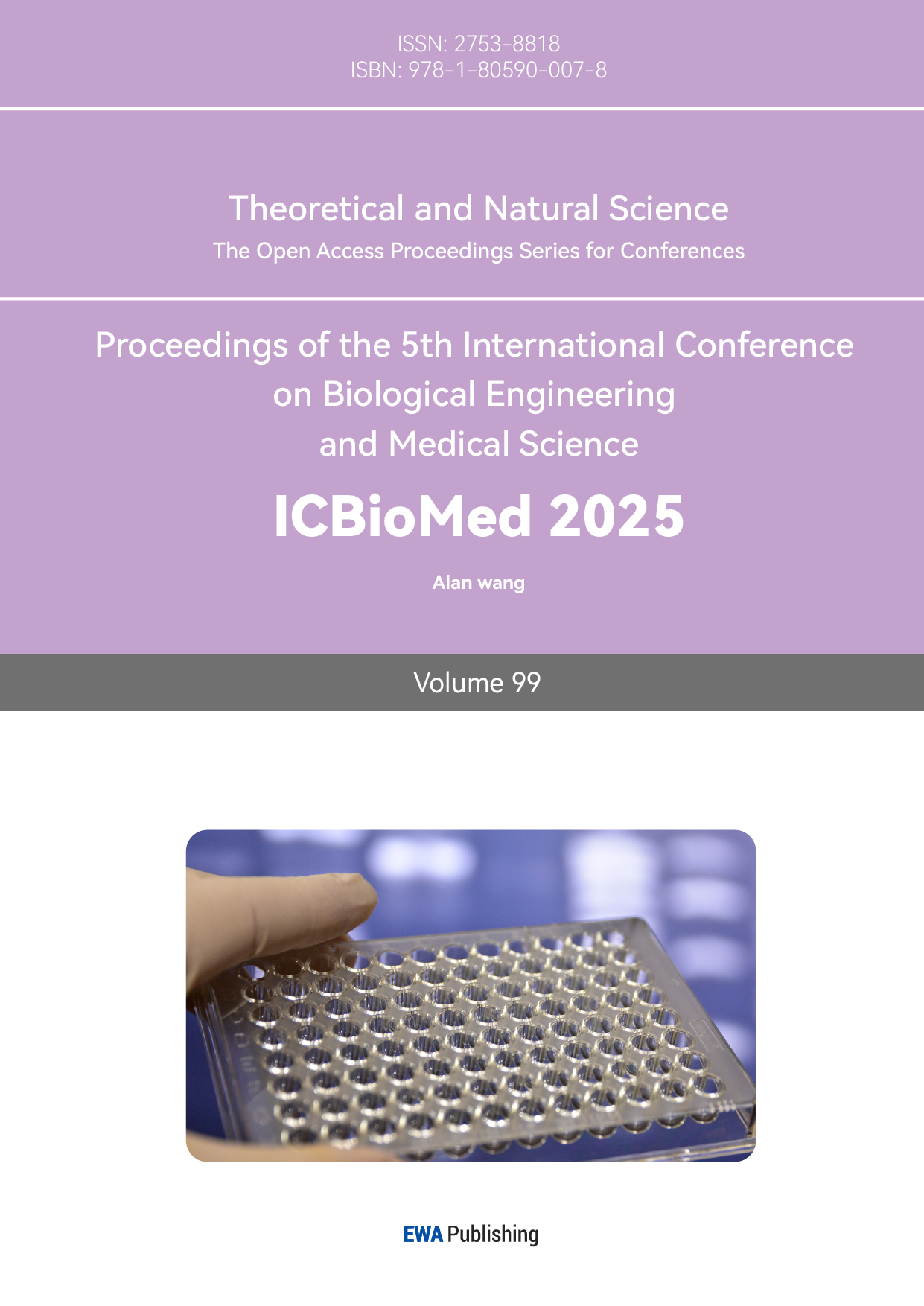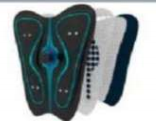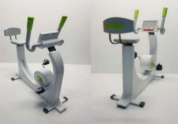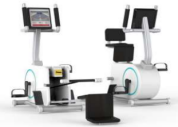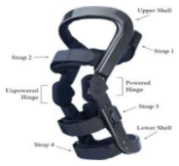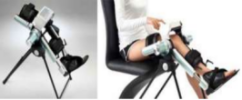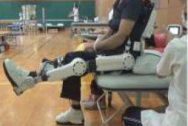1. Introduction
Osteoarthritis is a degenerative joint disease. Biochemical, metabolic, and immune changes are all considered to be associated with the onset of knee osteoarthritis (KOA), whose typical pathological features include articular cartilage degeneration, subchondral bone sclerosis, and osteophyte formation. It commonly affects weight-bearing joints such as the knees, hips, spine, and finger joints, and is a major cause of disability among the elderly [1]. Currently, there is no cure for KOA; only symptom control and mitigation are possible. Treatment requires long-term commitment and ongoing financial support [2]. For patients in the early to middle stages of KOA, treatment goals focus on pain relief, functional improvement, and halting disease progression. In order to accurately classify user need types, effectively determine the weight of user requirements, and scientifically evaluate design solutions, this study adopts a user model based on the KJ-AHP-TOPSIS method. Through scientific and objective approaches, it aims to develop KOA rehabilitation products that meet user satisfaction.
2. Research and analysis of knee osteoarthritis
2.1. Structural and pathological analysis of the knee joint
As one of the six major joints in the human body, the knee plays a crucial role in lower limb movement. It is one of the most complex limb joints and serves as the primary joint controlling lower extremity mobility [3]. Among all joint structures, the knee has the most abundant and complex muscle tissue. It bears more than 70% of the body’s weight, making it one of the joints most prone to injury [4]. Structurally, the knee joint consists of the patella, the distal femur, and the proximal tibia. The skeletal components mainly include the distal femur, proximal tibia, and patella. The joint capsule, which encloses the joint, connects these bones, while the surrounding ligaments reinforce the capsule’s stability [5]. The anterior and posterior cruciate ligaments, shown in Figure 1, form the cruciate ligament system of the knee. External to the capsule, auxiliary structural tissues such as the menisci, meniscal ligaments, and medial and lateral collateral ligaments provide further support.

Figure 1: Knee joint structure
KOA patients exhibit distinct physiological differences in their knee joints compared to healthy individuals, including muscle atrophy, subchondral bone remodeling and sclerosis, cartilage breakdown, ligament dysfunction, synovial hypertrophy, bone spur formation, and meniscal injuries [6], as shown in Figure 2.

Figure 2: KOA knee joint change characteristic diagram
This study focuses on assistive devices for early to mid-stage KOA patients for home use, aiming to intervene in the knee joint through acupoint massage to treat and prevent the progression of KOA, improve joint function, and alleviate pain.
2.2. Principles of acupoint massage for the knee joint
Research shows [7] that massage can reduce abnormal blood viscosity in KOA patients, relieve venous congestion, lower intra-articular pressure, increase pain threshold, and correct harmful stress caused by joint deformities. These effects help relieve KOA symptoms, slow disease progression, and reduce sequelae such as synovitis and joint adhesions.
Traditional Chinese medicine recommends six commonly used acupoints for KOA knee massage [8], with usage rates as follows: Neixiyan and Waixiyan (21%), Xuehai (19%), Liangqiu (18%), Yanglingquan (17%), Yinlingquan (12%), and Heding (13%). The top three in frequency are Neixiyan/Waixiyan, Xuehai, and Liangqiu. Figure 3 illustrates the locations of these acupoints.

Figure 3: Local treatment of acupoints
2.3. Physiological mechanism of vibration training
Vibration stimulation, as an additional external input, can alter the excitability of afferent nerve endings in muscle spindles, thereby modifying the recruitment of motor units [9]. Under active muscle contraction, added vibration stimuli can recruit more, or even all, motor units, simultaneously activating both type I and type II muscle fibers, resulting in increased muscle strength. Under specific loading conditions, smaller motor units are recruited first, while larger ones are activated last. However, vibration stimulation does not change this order but rather the recruitment method. As vibration frequency increases, so does the frequency and intensity of nerve impulses. Due to the combined influence of factors like vestibular mechanoreceptors, nearly all motor units involved are recruited simultaneously, enhancing the training effect of type II fibers. This increases the proportion of fast-twitch fibers and boosts muscle explosiveness [10].
2.4. Analysis of knee osteoarthritis rehabilitation products
(1) Domestic Rehabilitation Products
China’s rehabilitation industry has gone through a gradual development process, from slow initial growth, to a stable mid-stage, and to rapid development in recent years. Currently, many researchers have extended their focus to knee joint intervention aids, exploring the design and development of knee joint training products, human-machine interaction in the product usage process, and optimization design for human-computer interaction [11]. As shown in Table 1:
Table 1: Domestic rehabilitation products
Jinxinqin | Through investigation, experiment and ergonomics, a wearable knee joint intervention aid suitable for the elderly is designed. |
|
Liu Xiaohui | Through literature research, questionnaire survey and other methods, the existing products are investigated and analyzed, and finally the household cycling fitness products for middle-aged and elderly people are designed and expressed. |
|
Zhang Jingwen | This paper analyzes the shortcomings of the existing pedal intervention AIDS in the market, and designs a lower limb sports rehabilitation product with entertainment interactive experience based on the design concept of game thinking. |
|
(2) Foreign Rehabilitation Products
In comparison to domestic rehabilitation products, foreign knee joint fitness equipment has been developed earlier [12], with faster technological advancements. Many scholars are dedicated to researching and developing KOA exercise intervention aids with various therapeutic effects, such as pain relief, muscle strengthening, exercise monitoring, and health management. As shown in Table 2:
Table 2: Foreign rehabilitation products
Mechanical support assistive device | Budarick | The knee provides unloading function for the three chambers on the knee joint when carrying weight during exercise, so as to relieve the pain of patients with knee arthritis during exercise. |
|
Lower extremity sports AIDS | Kim | A new type of passive knee exercise equipment was developed to prevent postoperative stiffness but not to strengthen muscle exercise. Auxiliary robot |
|
Lower limb wearable robot | Yoshikawa | A set of mixed limb training AIDS was developed for KOA patients after total knee replacement. |
|
After sorting and analyzing the rehabilitation product cases at home and abroad, it can be observed that there is a lack of intervention products specifically targeting early and mid-stage KOA patients who have preserved independent mobility.
2.5. KOA user analysis
2.5.1. KOA patient analysis
Physiological Characteristics: Changes in Body Dimensions of Elderly Individuals: Research indicates that with increasing age, height tends to decrease, with women experiencing a more significant reduction than men. Other parts of the body also undergo corresponding changes, although these changes are often overlooked compared to the visual and proportional changes in height. Additionally, elderly individuals show variations in height, weight, muscle strength, and joint mobility compared to the general population.
Psychological Characteristics: As individuals transition from youth to middle age and then to old age, they tend to experience a relatively less optimistic psychological state. This condition can be divided into emotional changes and consumer psychology. Patients are generally more sensitive and fragile in terms of emotions compared to the average person. They may feel increasingly unnecessary in terms of both social status and self-worth, leading to a significant psychological gap, which can even cause feelings of inferiority. In terms of consumption, elderly individuals tend to prioritize practicality. They are more likely to purchase products that are simple to operate and have clear functions, and they are generally less receptive to new products compared to younger individuals. They prefer to use familiar products.
2.5.2. User group analysis
(1) Direct Users
The patient group, as direct users, needs to have direct contact with the rehabilitation aids and experience the functional services these aids provide. In the event of discomfort or an emergency, the user must promptly inform their family or physician to avoid causing secondary injuries to the affected area [13].
(2) Expert Users
The medical professional group, including physicians, is responsible for adjusting the rehabilitation aids before use by the patient and providing professional guidance. They adjust the equipment to match the patient’s dimensions and pathology, and monitor the patient’s usage within a certain range. Physicians can receive feedback from the patient in real-time and make adjustments to the device as necessary [14].
2.6. User model construction
Common methods used in modern design research to construct product design models driven by user needs include: Affinity Diagram (KJ), Kano Model (KANO), Quality Function Deployment (QFD), Analytic Hierarchy Process (AHP), Technique for Order of Preference by Similarity to Ideal Solution (TOPSIS), and the Theory of Inventive Problem Solving (TRIZ) [15]. The KJ method, also known as the Affinity Diagram or Card Method, is primarily used to encode, summarize, and analyze user demand indicators, providing a scientific basis for the establishment of subsequent demand models [16]. The AHP method is a multi-criteria decision-making approach that combines both qualitative and quantitative aspects. Given that KOA users tend to be more subjective, AHP has the advantage of being objective, systematic, simple, and practical. It is used to determine the weight of user demands derived from KJ, compensating for the limitations of traditional weight calculation methods, reducing the research workload, and improving the accuracy of weight calculations [17]. The TOPSIS method is a widely used multi-criteria decision-making tool, mainly applied in the comprehensive evaluation of solutions to multi-objective decisions. It effectively avoids subjective factors and is objective and valid. However, TOPSIS does not determine the weight of each indicator, so a prior weight analysis must be conducted. By combining AHP with TOPSIS, the data processing and assignment are efficient, simple, and fast [18]. This study focuses on the design of small home rehabilitation products for early-stage KOA users and aims to uncover deeper underlying indicators for the target users. These will be converted into design elements to provide scientific guidance for subsequent development. Therefore, this research integrates KJ, AHP, and TOPSIS methods to construct a product development model, clearly clustering and coding the demand points, accurately calculating the demand weights, and providing scientific decision-making for the design plan. The integrated KJ/AHP/TOPSIS product design model developed in this study is shown in Figure 4:
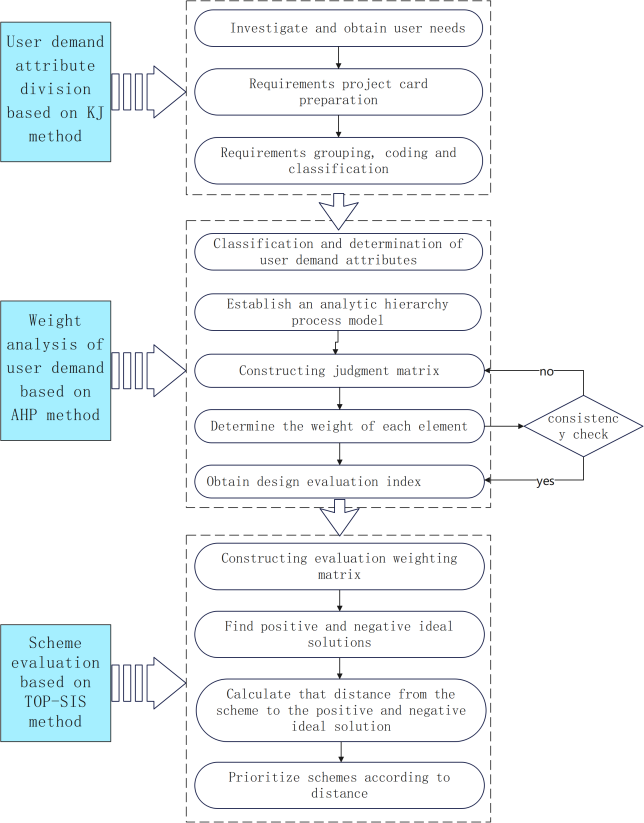
Figure 4: Product design model diagram
3. Product design process based on the integrated KJ/AHP/TOPSIS model
3.1. User demand attribute classification based on the KJ method
User demands for products are characterized by diversity, dynamics, and subjectivity. In order to uncover the multi-dimensional demands of KOA users, this study adopted both online and offline research methods, including literature review, user reviews, user interviews, and surveys, to gather comprehensive user demand data. After filtering and analysis, the initial user demands were identified. Then, according to the KJ method’s coding and classification attributes, the initial user indicators were divided into three types: product appearance, product performance, and product interaction experience. Demands with no significant difference and suspicious demands were excluded.
3.2. User demand weight calculation and analysis based on the AHP method
3.2.1. Hierarchical model construction
The AHP method, by combining qualitative factors with decision-related factors, extends the goal layer to the criteria layer, sub-criteria layer, and alternative solution layer. By constructing a judgment matrix, the weights of factors at each level are calculated, leading to a priority ranking of these factors. In this study, based on the user attribute classification from the KJ method, and following the hierarchical model principles of AHP, the optimal product design solution was set as the goal layer, product appearance, product performance, and product interaction experience as the criteria layer, and the indicators under each demand category as the sub-criteria layer. A hierarchical analysis model was constructed accordingly.
3.2.2. User demand weight calculation
A judgment matrix was constructed, and a 1–9 scale proposed by Saaty was used to compare and evaluate the importance of the indicators at the same level and assign values. The geometric average method was then applied to calculate the weight of indicators at the criteria and sub-criteria layers [19]. To ensure the logical feasibility of the judgment matrix and the consistency of the results, a consistency check was performed. If the consistency test failed, the judgment matrix was rechecked and modified before recalculating, repeating the process until it passed.
3.2.3. User demand weight analysis and solution conceptualization
Based on the calculated weight results, the user demands at each level were analyzed comprehensively. Priority was given to selecting the indicators with higher rankings. Considering the psychological characteristics of special populations, product solution concepts were developed, and ultimately, three design solutions were proposed.
3.3. Design solution evaluation based on the TOPSIS method
The TOPSIS method was employed to score the three rehabilitation product design solutions. The initial evaluation matrix was subjected to weighted normalization, and the positive and negative ideal solutions and relative closeness were calculated [20]. The three rehabilitation product design solutions were then ranked, and the optimal design solution for KOA rehabilitation products was selected. The procedure is as follows:
(1) Construct the Evaluation Matrix \( {X_{ij}} \)
\( {X_{ij}}=[\begin{matrix}x11 & x12 & ⋯ & x1n \\ x21 & x22 & ⋯ & x2n \\ ⋮ & ⋮ & ⋯ & ⋮ \\ xm1 & xm2 & ⋯ & xmn \\ \end{matrix}] \)
(2) Data Normalization Processing \( {y_{ij}} \)
Since different types of indicators can significantly affect the results, the influence of dimensions must be eliminated during the calculation. The data normalization process is as follows:
For positive indicators:
\( {y_{ij}}=\frac{{x_{ij}}-min({x_{j}})}{max({x_{j}})-min({x_{j}})} \)
For negative indicators:
\( {y_{ij}}=\frac{max{({x_{j}})}-{x_{ij}}}{max({x_{j}})-min({x_{j}})} \)
For moderate indicators:
\( {y_{ij}}=1-\frac{|{x_{ij-{d_{best}}}}|}{max|{x_{ij}}-{d_{best}}|} \)
(3) Weighted Normalized Matrix \( {Z_{ij}} \)
\( {Z_{ij}}={y_{ij}}*{w_{j}} \)
(4) Determine the Positive and Negative Ideal Solutions \( {Z^{+}} \) , \( {Z^{-}} \)
The positive ideal solution:
\( Z_{j}^{+}=max{({Z_{1j,}}{Z_{2j,}}…,{Z_{mj,}})} \)
The negative ideal solution:
\( Z_{j}^{-}=min({Z_{1j,}}{Z_{2j,}}…,{Z_{mj,}}) \)
The Euclidean distance formula for the positive and negative ideal solutions is:
\( d_{i}^{+}=\sqrt[]{\sum _{j=1}^{n}{({z_{ij}}-z_{j}^{+})^{2}}} \)
\( d_{i}^{-}=\sqrt[]{\sum _{j=1}^{n}{({z_{ij}}-z_{j}^{-})^{2}}} \)
The ideal closeness formula is:
\( {C_{i}}=\frac{d_{i}^{-}}{d_{i}^{-}+ d_{i}^{+}} \)
Finally, the priority of the evaluation scheme is determined by the value of 𝐶𝑖, with a higher value reflecting a higher priority for the solution.
4. KOA rehabilitation product design practice based on the KJ/AHP/TOPSIS model
4.1. KOA rehabilitation product user demand research
The aim of this study is to explore deeper KOA user demands. This was achieved by summarizing and screening KOA rehabilitation product literature from various major databases, ultimately identifying six representative research papers. Additionally, a user demand-oriented survey on KOA rehabilitation product design was distributed through Questionnaire Star, yielding 100 responses. After eliminating 18 invalid responses, 82 valid questionnaires were collected. In addition, user interviews were conducted with five early- to mid-stage KOA patients. The user demand information obtained from the above methods was converted semantically and merged for identical content. As a result, 20 initial user demands were identified and developed into demand project cards, which were then used as initial project requirements. Figure 5 shows the initial user requirements:
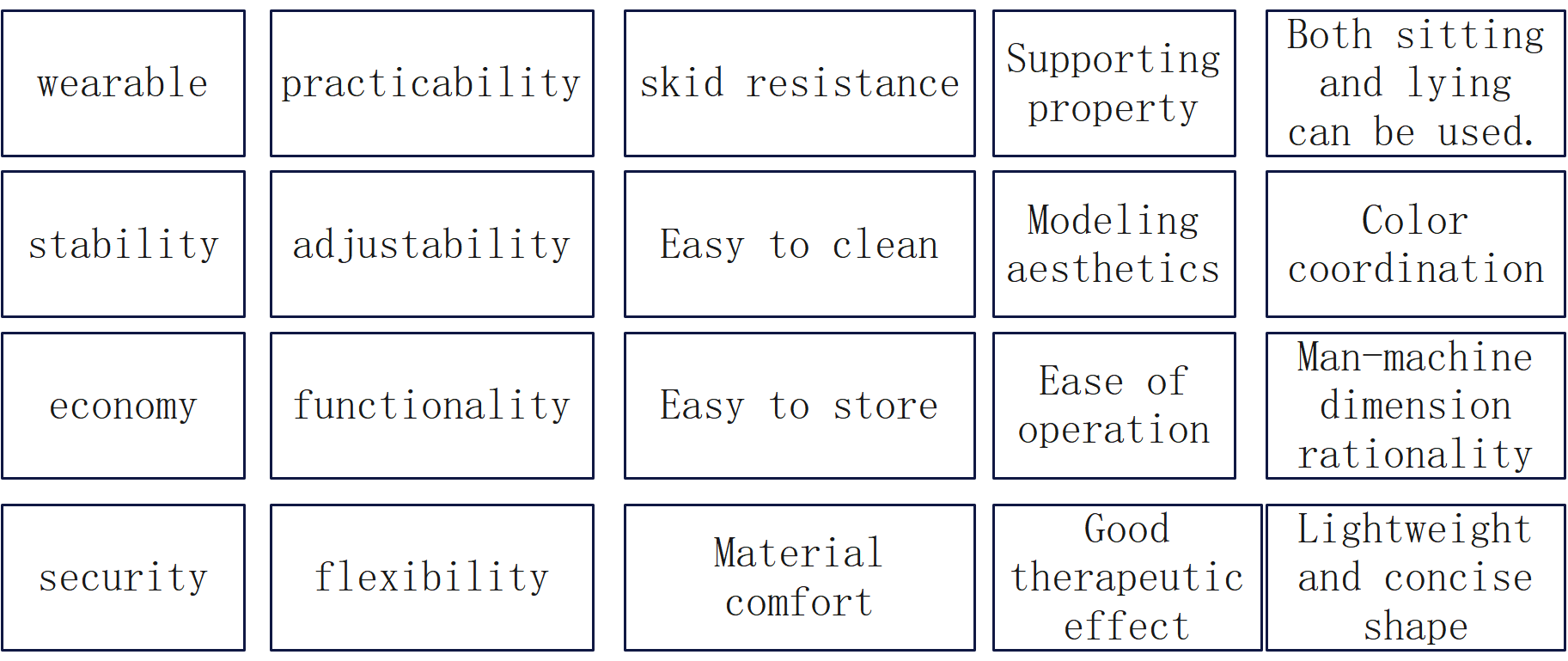
Figure 5: Initial user requirements
4.2. User demand attribute classification for KOA rehabilitation products based on the KJ method
In order to better integrate KOA user demand information into the design, the 20 initial user demand indicators for KOA users were grouped, encoded, and classified using the KJ method (Affinity Diagram). The advantages of this method include: ① Diverging thinking during classification, discovering latent user needs, and improving the collected demand items. ② Organizing and classifying the existing initial user demands, which helps form a clear hierarchy of needs and ensures that the demands are refined.
Encoding Method: Similar initial user demand items were grouped together, with the codes at the beginning of each group being consistent. The resulting attribute classification of the KOA initial user demand cards is shown in Figure 6:
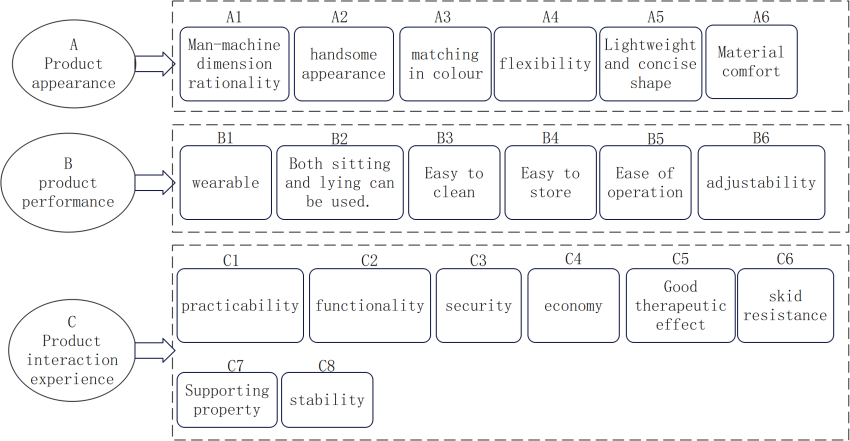
Figure 6: Attribute division of original user demand card
4.3. KOA rehabilitation product user demand weight calculation and analysis based on the AHP method
4.3.1. KOA rehabilitation product hierarchical analysis model construction
Based on the KOA user demand attributes classified using the KJ method, a hierarchical analysis model was constructed. The goal layer, represented by A, is the optimal design solution for the KOA rehabilitation product. The criteria layer consists of three levels: product appearance, product performance, and product interaction experience, represented by B1, B2, and B3, respectively. The sub-criteria layers under product appearance (B1), product performance (B2), and product interaction experience (B3) are represented as B11, B12, and so on for B1; B21, B22, and so on for B2; and B31, B32, and so on for B3. This model is illustrated in Figure 7:
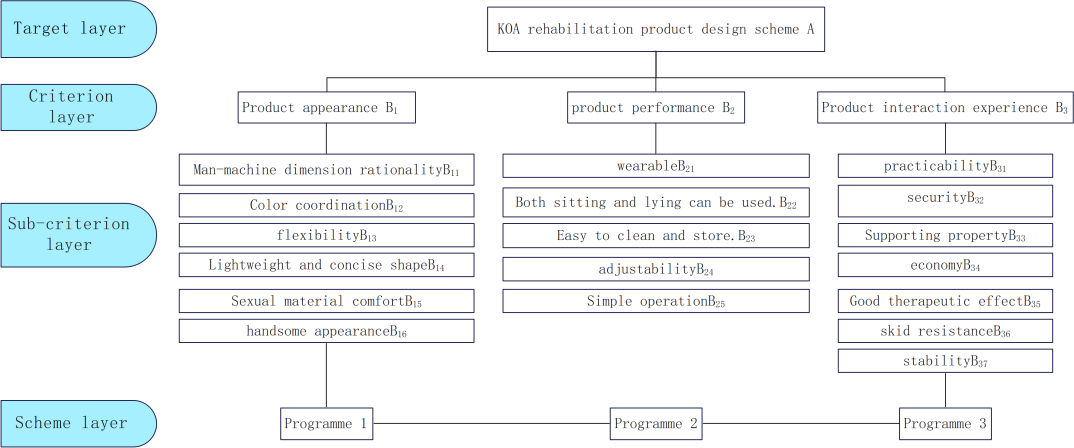
Figure 7: Analytic hierarchy process model
4.3.2. KOA rehabilitation product user demand weight calculation
The Analytic Hierarchy Process (AHP) displays the relationships between factors through a hierarchical structure. However, different decision-makers may have inconsistent views regarding the importance of various factors. The selected evaluators include: ① KOA users who are currently using rehabilitation products, as this group has a higher level of awareness and familiarity with rehabilitation products; ② Users who wish to purchase or have already purchased KOA rehabilitation products, as this group has certain expectations regarding these products. In total, 15 evaluators were selected, including the two groups above, as well as professional designers. The evaluators were asked to conduct pairwise comparisons of the primary and secondary indicators using Saaty’s standardized 1-9 scale and to quantify these comparisons. Weight vectors were then calculated, and a judgment matrix was constructed. The results are shown in Table 3-6:
Table 3: A corresponding judgment matrix, weight, and consistency test results
Tab. 3 A Corresponding Judgment Matrix, Weight, and Consistency Test ResultsA | B1 | B2 | B3 | Relative weight | consistency check |
B1 | 1 | 1 | 1 | 0.3278 | \( {_{max}} \) =3.0537 CI=0.0268 RI=0.52 CR=0.0516 |
B2 | 1 | 1 | 2 | 0.4111 | |
B3 | 1 | 1/2 | 1 | 0.2611 |
Table 4: B1 corresponding judgment matrix, weight, and consistency test results
B1 | B11 | B12 | B13 | B14 | B15 | B16 | Relative weight | Consistency check |
B11 | 1 | 4 | 4 | 1/3 | 5 | 3 | 0.2568 | \( {_{max}} \) =6.6010 CI=0.1202 RI=1.26 CR=0.0954 |
B12 | 1/4 | 1 | 1 | 1/5 | 2 | 1 | 0.0850 | |
B13 | 1/4 | 1 | 1 | 1/7 | 2 | 1 | 0.0808 | |
B14 | 3 | 5 | 7 | 1 | 4 | 3 | 0.4084 | |
B15 | 1/5 | 1/2 | 1/2 | 1/4 | 1 | 3 | 0.0908 | |
B16 | 1/3 | 1 | 1 | 1/3 | 1/3 | 1 | 0.0782 |
Table 5: B2 corresponding judgment matrix, weight, and consistency test results
B2 | B21 | B22 | B23 | B24 | B25 | Relative weight | Consistency check |
B21 | 1 | 1 | 3 | 2 | 1 | 0.2532 | \( {_{max}} \) =5.0820 CI=0.0205 RI=1.12 CR=0.0183 |
B22 | 1 | 1 | 5 | 3 | 1 | 0.3088 | |
B23 | 1/3 | 1/5 | 1 | 1 | 1/2 | 0.0926 | |
B24 | 1/2 | 1/3 | 1 | 1 | 1/2 | 0.1088 | |
B25 | 1 | 1 | 2 | 2 | 1 | 0.2366 |
Table 6: B3 corresponding judgment matrix, weight, and consistency test results
B3 | B31 | B32 | B33 | B34 | B35 | B36 | B37 | Relative weight | consistency check |
B31 | 1 | 1 | 1 | 2 | 1 | 1 | 1/3 | 0.1179 | \( {_{max}} \) =7.3742 CI=0.0624 RI=1.36 CR=0.0459 |
B32 | 1 | 1 | 1 | 2 | 1 | 1/2 | 1/4 | 0.1031 | |
B33 | 1 | 1 | 1 | 1 | 1/3 | 1/2 | 1/2 | 0.0934 | |
B34 | 1/2 | 1/2 | 1 | 1 | 1 | 1 | 1/5 | 0.0856 | |
B35 | 1 | 1 | 3 | 1 | 1 | 1/2 | 1/3 | 0.1219 | |
B36 | 1 | 2 | 2 | 1 | 2 | 1 | 1/2 | 0.1565 | |
B37 | 3 | 4 | 2 | 5 | 3 | 2 | 1 | 0.3215 |
In summary, the data for the goal layer (A) and the criteria layer, which include product appearance (B1), product performance (B2), and product interaction experience (B3), all passed the consistency check. The calculated comprehensive weights for each factor are valid and accurate.
4.4. KOA rehabilitation product design scheme
In the product design process, the top six factors based on the weight rankings are prioritized. These factors are: Lightweight and simple shape (B14), Usable for both sitting and lying (B22), Wearable (B21), Easy to operate (B25), Man-machine dimension rationality (B11), and Stability (B37). In order to design scientific and effective rehabilitation products, a balance and trade-off among the various indicator factors are made to find an appropriate equilibrium point in the design objectives. Three rehabilitation product schemes were designed.
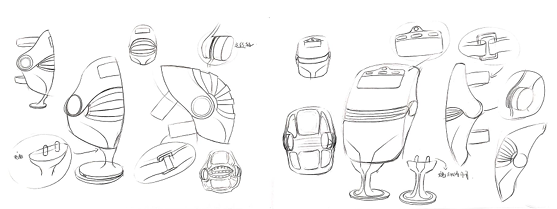
Figure 8: Design sketch
4.5. KOA rehabilitation product design evaluation based on TOPSIS
To ensure the objectivity of the scheme selection and to avoid subjective biases caused by the decision-maker’s awareness, the priority ranking of each scheme is scientifically determined. The 18 demand factors from the Analytic Hierarchy Process (AHP) model are used as evaluation indicators in the TOPSIS decision-making process, all of which are positive indicators. Fifteen smart shoe cabinet design experts were selected to evaluate the 18 indicators for the three design schemes mentioned above. The Likert 7-point scale was used for scoring (1-7, representing: Very bad, Bad, Poor, Average, Good, Very good, Excellent). After averaging the scores, the initial evaluation matrix F was obtained, as shown in Table 7.
Table 7: Original index data
Indicator name | Scheme No.1 | Scheme No.2 | Scheme No.3 |
B11 Man-machine dimension rationality | 3.2 | 4.13 | 3.87 |
B12 Color coordination | 4.73 | 4.8 | 3.93 |
B13 flexibility | 3 | 2.53 | 4 |
B14 Lightweight and concise shape | 4.07 | 3.73 | 3.33 |
B15 Material comfort | 3.13 | 2.8 | 4.53 |
B16 handsome appearance | 3.4 | 4 | 3 |
B21 wearable | 4.8 | 2.73 | 4 |
B22 Both sitting and lying can be used. | 4.67 | 4.73 | 4.4 |
B23 Easy to clean and store | 4.67 | 4.13 | 2.73 |
B24 adjustability | 3.27 | 2.93 | 4.6 |
B25 Simple operation | 4.53 | 4.67 | 4 |
B31 practicability | 4.73 | 2.53 | 4.13 |
B32 security | 4.6 | 2.67 | 4.87 |
B33 Supporting property | 4.87 | 2.8 | 3.8 |
B34 economy | 4.2 | 2.8 | 4.27 |
B35 Good therapeutic effect | 4 | 4.47 | 2.53 |
B36 skid resistance | 4.87 | 4.87 | 4.47 |
B37 stability | 4.93 | 2.87 | 3.87 |
According to the TOPSIS calculation procedure, the positive and negative ideal solutions and relative closeness for each scheme are derived, as shown in Table 8. Scheme 1 has the highest Ci value, indicating that Scheme 1 is the best.
Table 8: Euclidean distance, closeness, and closeness ranking of three schemes
Name | Forward ideal solution distance | Negative ideal solution distance | Relative closeness |
Scheme No.1 | 0.1026 | 0.2444 | 0.7044 |
Scheme No.2 | 0.1677 | 0.2068 | 0.5522 |
Scheme No.3 | 0.2309 | 0.1220 | 0.3456 |
4.6. Design results
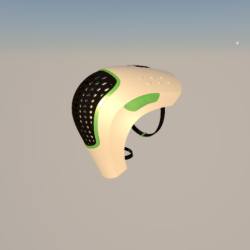
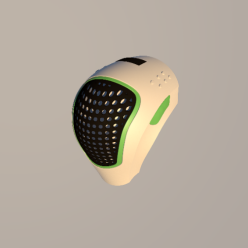

Figure 9: Product model
5. Conclusion
This study focused on the design of rehabilitation products for moderate to mild KOA users. To minimize the interference of subjective judgments in the design process and ensure the scientific and rationality of the product design strategy, this study integrated the KJ method, AHP (Analytic Hierarchy Process), and the TOPSIS evaluation system. A comprehensive and objective KOA rehabilitation product design assessment and optimization method was proposed, and the product design process for KOA rehabilitation products was examined. The results show that based on the KJ-AHP-TOPSIS model, KOA rehabilitation products can be developed and designed more effectively. This approach can reasonably and effectively address the potential needs of users, making the product more scientific and aligning it better with user needs. The model provides a more scientific and efficient design experience for product development.
References
[1]. Rousseau, J. C., & Delmas, P. D. (2007). Biological markers in osteoarthritis. Nature Clinical Practice Rheumatology, 3(6), 346-356.
[2]. Deng, X., Li, J., Ceng, H. J., et al. (2012). Analytic hierarchy process weight calculation method and its application research. Practice and Understanding of Mathematics, 42(7), 93-100.
[3]. Li, Y., & Zhang, J. (2018). Healing products based on emotional comfort and their design principles. Hunan Packaging, 33(5), 19-21.
[4]. Wang, Z., & Liu, H. (2009). On the application of human-computer interaction principles in product design. Journal of Engineering Graphics, 30(2), 126-129.
[5]. Chen, X., & Qiu, D. (2019). Research on product design based on fuzzy Kano model and TOPSIS method. Journal of Graphics, 40(2), 315-320.
[6]. Zou, T., & Zhu, J. (2020). Evaluation method of innovative design thinking of equipment manufacturing enterprises. Mechanical Design, 37(9), 140-144.
[7]. Su, J., & Wei, J. (2020). Design of Rose Bud Picker based on AHP/QFD/TRIZ. Mechanical Design, 37(8), 121-126.
[8]. Wang, N., & Wang, J. (2018). Research on the modeling design of home service robots facing perceptual needs. Mechanical Design, 35(11), 111-116.
[9]. Liu, X., & Zhu, D. (1990). Selection and judgment: AHP (Analytic Hierarchy Process) decision. Shanghai: Shanghai Science Popularization Press.
[10]. Wei, Y., Yang, Y., & Chen, K. (2018). Research on the improved design of the Internet car app based on KJ method. Packaging Engineering, 39(14), 146-152.
[11]. Shen, Y., Liu, F., Cao, H., et al. (2011). Clinical manifestations of patients with knee osteoarthritis and related influencing factors. China Tissue Engineering Research and Clinical Rehabilitation, 09, 1643-1646.
[12]. Chen, H. (2014). Clinical study on the treatment of knee osteoarthritis with three different acupuncture methods (Doctoral dissertation). Guangzhou University of Chinese Medicine.
[13]. Dang, P. (2010). Analysis of China’s aging society. Reform and Opening Up, 24, 144-145.
[14]. Gao, L. (2009). Clinical observation on 51 cases of knee osteoarthritis treated by comprehensive therapy. Chinese and Foreign Medical, 28(34), 34-34
[15]. Song, M., & Du, M. (2005). Development of micro intelligent kneepads for prevention and treatment of knee osteoarthritis. Chinese Journal of Scientific Instrument, S2, 304-306.
[16]. Lin, M., Liu, X., Li, X., et al. (2009). Effect of knee pads for therapeutic arthritis on histomorphology of experimental osteoarthritis. China Tissue Engineering Research and Clinical Rehabilitation, 04, 611-616.
[17]. Jiang, Y., Song, L., & Liu, L. (2015). Application of KJ method in improved design. Art and Design, 09, 95-97.
[18]. Duan, J., Hou, Z., & Stone, P. (2021). Research on textile machinery modeling design based on analytic hierarchy process. Packaging Engineering, 42(12), 98-104.
[19]. Su, C., Zhang, H., & Cheng, S. (2022). Ergonomic study of wearable lower limb rehabilitation exoskeleton based on CATIA. Industrial Engineering, 25(1), 160-165.
[20]. Tang, X., & Li, C. (2021). Research on innovative design of electric scooter for the elderly by integrating SET/AHP/TRIZ. Mechanical Design, 38(S2), 113-117.
Cite this article
Li,L.;Yang,S. (2025). Design Study of Assistive Rehabilitation Products for Mild to Moderate KOA Based on the KJ-AHP-TOPSIS Model. Theoretical and Natural Science,99,164-176.
Data availability
The datasets used and/or analyzed during the current study will be available from the authors upon reasonable request.
Disclaimer/Publisher's Note
The statements, opinions and data contained in all publications are solely those of the individual author(s) and contributor(s) and not of EWA Publishing and/or the editor(s). EWA Publishing and/or the editor(s) disclaim responsibility for any injury to people or property resulting from any ideas, methods, instructions or products referred to in the content.
About volume
Volume title: Proceedings of the 5th International Conference on Biological Engineering and Medical Science
© 2024 by the author(s). Licensee EWA Publishing, Oxford, UK. This article is an open access article distributed under the terms and
conditions of the Creative Commons Attribution (CC BY) license. Authors who
publish this series agree to the following terms:
1. Authors retain copyright and grant the series right of first publication with the work simultaneously licensed under a Creative Commons
Attribution License that allows others to share the work with an acknowledgment of the work's authorship and initial publication in this
series.
2. Authors are able to enter into separate, additional contractual arrangements for the non-exclusive distribution of the series's published
version of the work (e.g., post it to an institutional repository or publish it in a book), with an acknowledgment of its initial
publication in this series.
3. Authors are permitted and encouraged to post their work online (e.g., in institutional repositories or on their website) prior to and
during the submission process, as it can lead to productive exchanges, as well as earlier and greater citation of published work (See
Open access policy for details).
References
[1]. Rousseau, J. C., & Delmas, P. D. (2007). Biological markers in osteoarthritis. Nature Clinical Practice Rheumatology, 3(6), 346-356.
[2]. Deng, X., Li, J., Ceng, H. J., et al. (2012). Analytic hierarchy process weight calculation method and its application research. Practice and Understanding of Mathematics, 42(7), 93-100.
[3]. Li, Y., & Zhang, J. (2018). Healing products based on emotional comfort and their design principles. Hunan Packaging, 33(5), 19-21.
[4]. Wang, Z., & Liu, H. (2009). On the application of human-computer interaction principles in product design. Journal of Engineering Graphics, 30(2), 126-129.
[5]. Chen, X., & Qiu, D. (2019). Research on product design based on fuzzy Kano model and TOPSIS method. Journal of Graphics, 40(2), 315-320.
[6]. Zou, T., & Zhu, J. (2020). Evaluation method of innovative design thinking of equipment manufacturing enterprises. Mechanical Design, 37(9), 140-144.
[7]. Su, J., & Wei, J. (2020). Design of Rose Bud Picker based on AHP/QFD/TRIZ. Mechanical Design, 37(8), 121-126.
[8]. Wang, N., & Wang, J. (2018). Research on the modeling design of home service robots facing perceptual needs. Mechanical Design, 35(11), 111-116.
[9]. Liu, X., & Zhu, D. (1990). Selection and judgment: AHP (Analytic Hierarchy Process) decision. Shanghai: Shanghai Science Popularization Press.
[10]. Wei, Y., Yang, Y., & Chen, K. (2018). Research on the improved design of the Internet car app based on KJ method. Packaging Engineering, 39(14), 146-152.
[11]. Shen, Y., Liu, F., Cao, H., et al. (2011). Clinical manifestations of patients with knee osteoarthritis and related influencing factors. China Tissue Engineering Research and Clinical Rehabilitation, 09, 1643-1646.
[12]. Chen, H. (2014). Clinical study on the treatment of knee osteoarthritis with three different acupuncture methods (Doctoral dissertation). Guangzhou University of Chinese Medicine.
[13]. Dang, P. (2010). Analysis of China’s aging society. Reform and Opening Up, 24, 144-145.
[14]. Gao, L. (2009). Clinical observation on 51 cases of knee osteoarthritis treated by comprehensive therapy. Chinese and Foreign Medical, 28(34), 34-34
[15]. Song, M., & Du, M. (2005). Development of micro intelligent kneepads for prevention and treatment of knee osteoarthritis. Chinese Journal of Scientific Instrument, S2, 304-306.
[16]. Lin, M., Liu, X., Li, X., et al. (2009). Effect of knee pads for therapeutic arthritis on histomorphology of experimental osteoarthritis. China Tissue Engineering Research and Clinical Rehabilitation, 04, 611-616.
[17]. Jiang, Y., Song, L., & Liu, L. (2015). Application of KJ method in improved design. Art and Design, 09, 95-97.
[18]. Duan, J., Hou, Z., & Stone, P. (2021). Research on textile machinery modeling design based on analytic hierarchy process. Packaging Engineering, 42(12), 98-104.
[19]. Su, C., Zhang, H., & Cheng, S. (2022). Ergonomic study of wearable lower limb rehabilitation exoskeleton based on CATIA. Industrial Engineering, 25(1), 160-165.
[20]. Tang, X., & Li, C. (2021). Research on innovative design of electric scooter for the elderly by integrating SET/AHP/TRIZ. Mechanical Design, 38(S2), 113-117.





